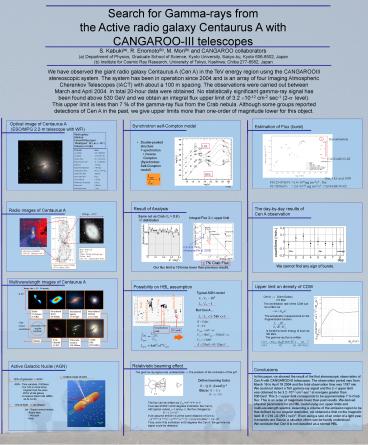Radio galaxy - PowerPoint PPT Presentation
1 / 1
Title:
Radio galaxy
Description:
Search for Gamma-rays from the Active radio galaxy Centaurus A with CANGAROO-III telescopes 60 Cen A S. Kabuki(a), R. Enomoto(b), M. Mori(b) and CANGAROO collaborators – PowerPoint PPT presentation
Number of Views:50
Avg rating:3.0/5.0
Title: Radio galaxy
1
Search for Gamma-rays from the Active radio
galaxy Centaurus A with CANGAROO-III telescopes
S. Kabuki(a), R. Enomoto(b), M. Mori(b) and
CANGAROO collaborators (a) Department of
Physics, Graduate School of Science, Kyoto
University, Sakyo-ku, Kyoto 606-8502, Japan (b)
Institute for Cosmic Ray Research, University of
Tokyo, Kashiwa, Chiba 277-8582, Japan
We have observed the giant radio galaxy Centaurus
A (Cen A) in the TeV energy region using the
CANGAROOIII stereoscopic system. The system has
been in operation since 2004 and is an array of
four Imaging Atmospheric Cherenkov Telescopes
(IACT) with about a 100 m spacing. The
observations were carried out between March and
April 2004. In total 20-hour data were obtained.
No statistically significant gamma-ray signal
has been found above 530 GeV and we obtain an
integral flux upper limit of 3.2 ?10-12 cm-2
sec-1 (2-? level). This upper limit is less than
7 of the gamma-ray flux from the Crab nebula.
Although some groups reported detections of Cen A
in the past, we give upper limits more than
one-order of magnitude lower for this object.
Optical image of Centaurus A (ESO/MPG 2.2-m
telescope with WFI)
Synchrotron self-Compton model
Estimation of Flux (burst)
Radio galaxy Elliptical Fanaroff-Riley type
I Misaligned BL Lac ( 60?) Distance 3.5 Mpc
Bai estimation
- Double-peaked structure synchrotron
inverse Compton(Synchrotron Self-Compton
model)
LBL
Parameter Value ?
(J2000) 201?.3650633
? (J2000)
-43?.0191125 Galaxy Size
18 ? 14 arcmin Radio Source size
8 ? 4 degrees Distance
3.5 Mpc Apparent Magnitude 7.96
mag Total galaxy mass (4?1) ? 1011
M? Outer radio lobe 250 kpc
Inner radio lobe 5 kpc Inner
radio jet 1.35
kpc Relativistic nuclear jet 1.65
pc Radio core 0.008
pc Dust lane radius 7 kpc
CANGAROO-III
HBL
Bai, J.M. et al 1999
F(0.25-30TeV) 6.4?10-9 erg cm-2 s-1
Bai F(gt530GeV) 2.6?10-12 erg cm-2 s-1
CANGAROO-III
? ray
The day-by-day results of Cen A observation
Result of Analysis
Radio images of Centaurus A
30 kpc 0.3?
Same cut as Crab ( L gt 0.9 ) ?2 distribution
Integral Flux 2-? upper limit
H.E.S.S. limit (Aharonian et al, 2005)
Blue Radio jet Red CO White Atomic
hydrogen gas Yellow shell (32 ?32,
Charmandaris 2000)
Outer lobes (408MHz) (20o?20o, Haslman 1982 )
? 7 Crab Flux
We cannot find any sign of bursts.
Outer lobes 6.9cm(4.75GHz) (5o?9o, Junkes 1993)
Our flux limit is 10 times lower than previous
results.
Multiwavelength images of Centaurus A
Upper limit on density of CDM
Possibility on HBL assumption
Image size 15 ? 14 arcmin
Typical AGN model
0.25o
Cen A ? Giant Galaxy 3.5 Mpc
Gamma (TeV)
X ray
The annihilation rate of the CDM can be written
as
Radio
But Cen A
Infrared / optical
Far infrared IRAS 60-100?m
Near infrared 2MASS 1.2-2.17?m
.
Radio VLA(6cm) 4.9GHz
Mid infrared Spitzer 3.6 to 8?m
The accelerator measurement on the fragmentation
function
Gamma (MeV)
One event resolution
CANGAROO-III Angular resolution
Synchrotron peak
IC peak
is limited to lower energy of such as 100 MeV.
The gamma-ray flux is written
Visible DSS 405-645nm
X-ray Chandra 1-3 keV
Ultraviolet GALEX 130-300nm
Gamma
Relativistic beaming effect
Active Galactic Nuclei (AGN)
Conclusions
The gamma-ray signal was undetectable.? The
problem of the inclination of the jet?
In this paper, we showed the result of the first
stereoscopic observation of Cen A with
CANGAROO-III telescopes. The observation period
was from March 16 to April 19 2004 and the total
observation time was 1197 min. We could not
detect a TeV gamma-ray signal and the 2-? upper
limit was obtained to be 3.2?10-12 cm-2 sec-1 at
energies greater than 530 GeV. This 2-? upper
limit corresponds to be approximately 7 -Crab
flux. This is an order of magnitude lower than
past results. We derived physical parameters for
an HBL model using our upper limits and
multi-wavelength spectra. Assuming a volume of
the emission region to be that defined by our
angular resolution, we obtained a limit on the
magnetic field B gt 210 ?G (R/12 kpc)-1. Even
using a size of an order of a light year, it
exceeds one Gauss, a situation which can be
hardly understood. We conclude that Cen A is not
classified as a normal HBL.
Unified model of AGN
10 of galaxies ? AGN AGN - Time variation
(1000sec) - It is 100 or more times
brighter than the stars
of the whole galaxy. - A massive
black hole (MBH) as its nuclei
10 of AGN ? Jet (Blazar) Jet
- Super luminal motion - Radio lobe
- Hot spot - Knot
Define beaming factor
d ? (1-b cosq)-1
Blazar ? 1/ ? d ? 10
The flux can be written as Fobs?2aF ?p F. If
we see Mrk501 at 60 degrees inclination like Cen
A, with typical values, ?5 and p3, the flux
changes by ?p 1.310-4 . If we
assume Mrk501 is at the same distance of Cen A,
(F Mrk501/F CenA)2 (z Mrk501/z Cen A)2
(0.034/0.0008)2 1.8?104 Thus, even if its
inclination is 60 degrees like Cen A, the
gamma-ray signal could be detected.































